Slow-Roasted Salmon with French Herb Salsa
- By Jennifer Segal
- Updated April 3, 2025
- 331 Comments
- Leave a Review

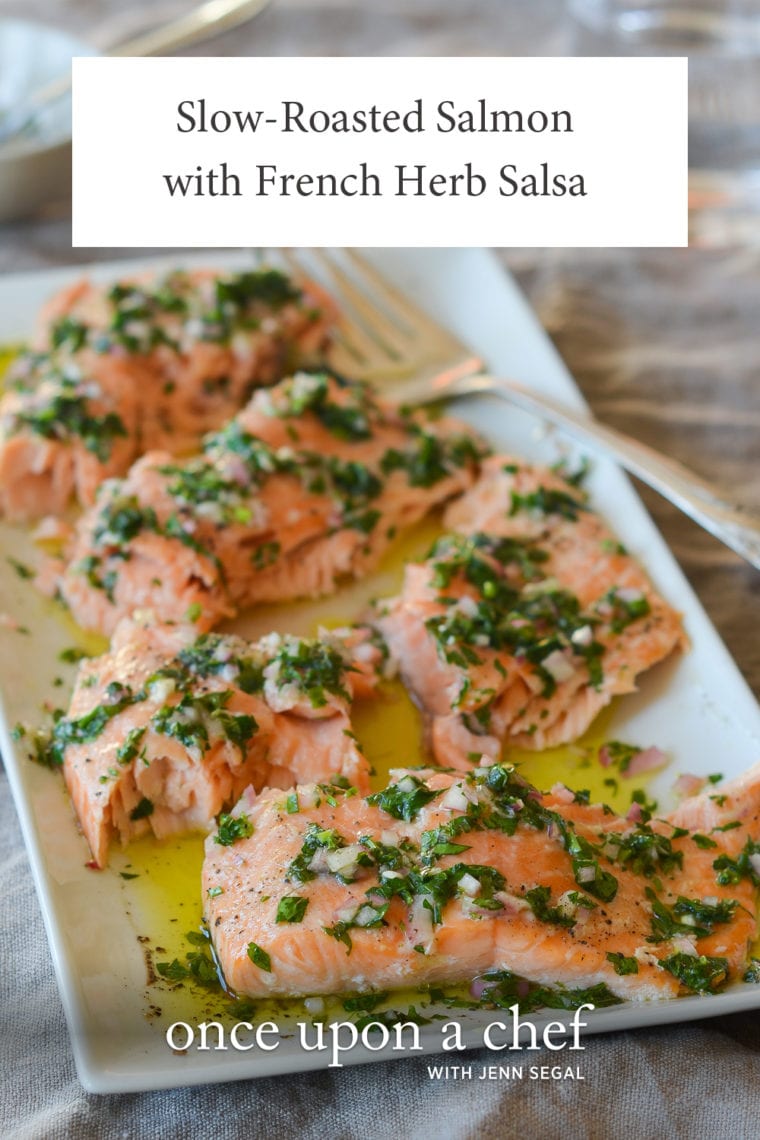
This post may contain affiliate links. Read my full disclosure policy.
Want to impress your guests without stressing? This slow-roasted salmon with fresh herb salsa looks impressive, tastes amazing, and couldn’t be easier. Serve it warm, chilled, or at room temp—whatever works for you.
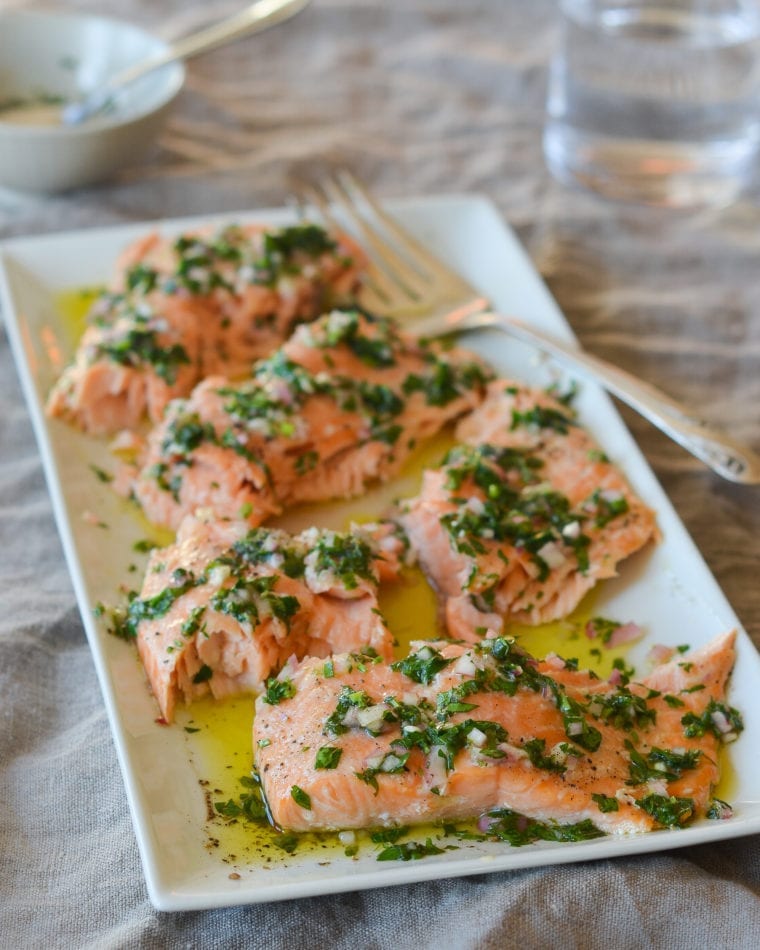
This slow-roasted salmon recipe, a gem from Samin Nosrat’s acclaimed Salt, Fat, Acid, Heat, has become a favorite in my kitchen. Her method is brilliant—roasting the salmon low and slow makes it almost impossible to overcook the fish. It stays super moist and just a little translucent, even when it’s fully cooked. Like a lot of Samin’s recipes, this one’s more of a technique than a strict formula, and she includes a few variations and sauces to play around with.
I usually serve it with a simple herb salsa—just macerated shallots, olive oil, and a mix of soft herbs. It takes no time at all and adds so much flavor.
You can serve the salmon warm, cold, or at room temp (that’s my favorite), and it always feels a little fancy, especially on a holiday buffet. It’s delicious alongside roasted potatoes, a simple green salad, or roasted asparagus. The fact that you can make it ahead is a huge bonus when you’re hosting.
“So tender – melt in your mouth. The sauce is excellent. Incredibly simple yet beautiful presentation. My new go to salmon recipe.”
What you’ll need To Make Slow-Roasted Salmon
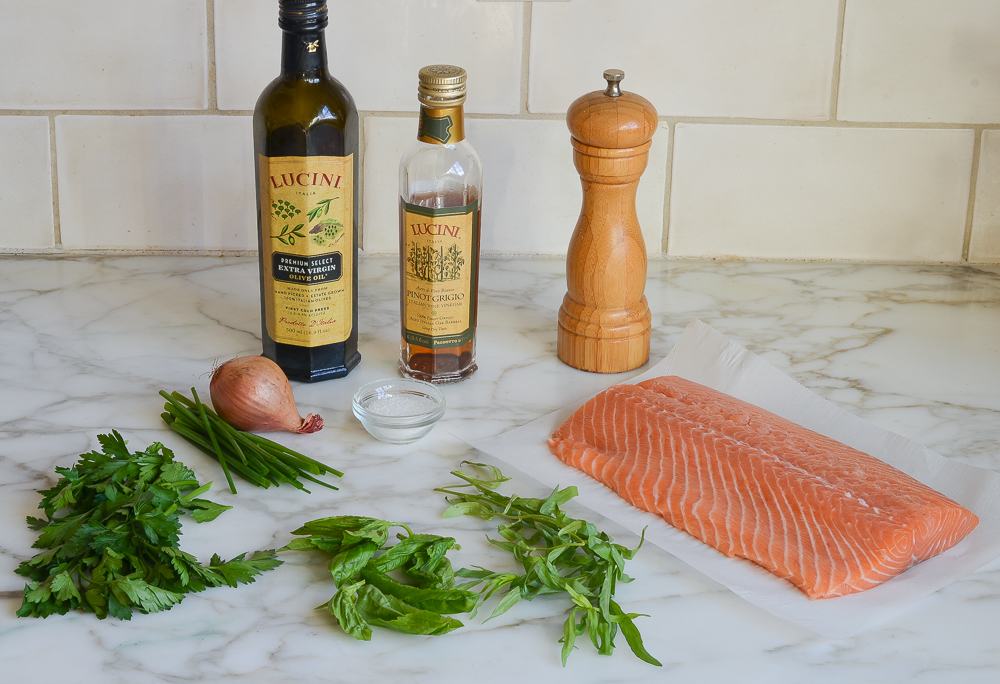
- Salmon Filet: You can ask your fishmonger to remove the skin for convenience. If you don’t, it’s easy to remove once the salmon is cooked; just slide a thin metal spatula between the flesh and skin when serving.
- Extra-Virgin Olive Oil: Used to coat the salmon for moisture and richness, and as the base for the herb salsa.
- Shallot: Adds a mild, slightly sweet onion flavor to the salsa.
- White Wine Vinegar: Provides bright acidity to balance the richness of the salmon and round out the salsa.
- Fresh Italian Parsley, Chervil, Chives, Basil, And Tarragon: A blend of fresh herbs that gives the salsa its bright, fresh flavor and loads of aroma.
- Jump to the printable recipe for precise measurements
Step-by-Step Instructions
Step 1. Prep the salmon. Place the salmon on a baking sheet, drizzle with olive oil, and sprinkle evenly with salt.
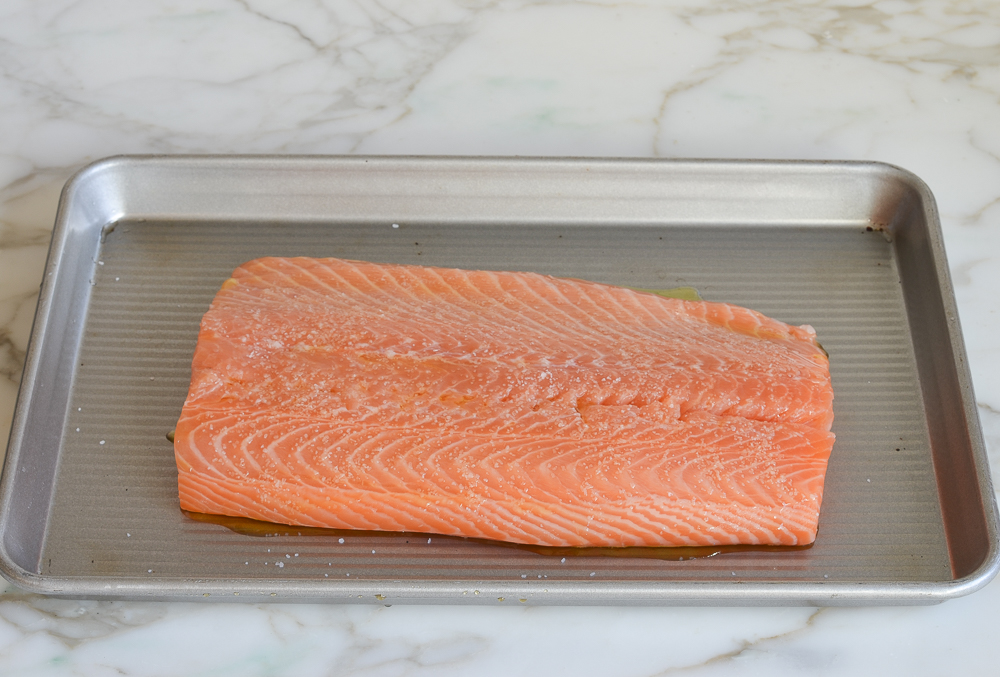
Step 2. Roast the salmon. Roast for 40 to 50 minutes in a 225°F oven until the thickest part flakes easily when pressed with a knife or your finger. It will still look a little translucent even when fully cooked.
Pro Tip: Slow-roasting keeps the fish tender, prevents it from seizing up, and reduces the amount of white protein (albumin) that surfaces. If you see a bit (like below), simply scrape it off with a spoon.

Step 3. Macerate the shallots. In a small bowl, combine the shallot and vinegar and let sit for 15 minutes.
Pro Tip: Macerating mellows the sharp bite of the shallot and enhances its natural sweetness.
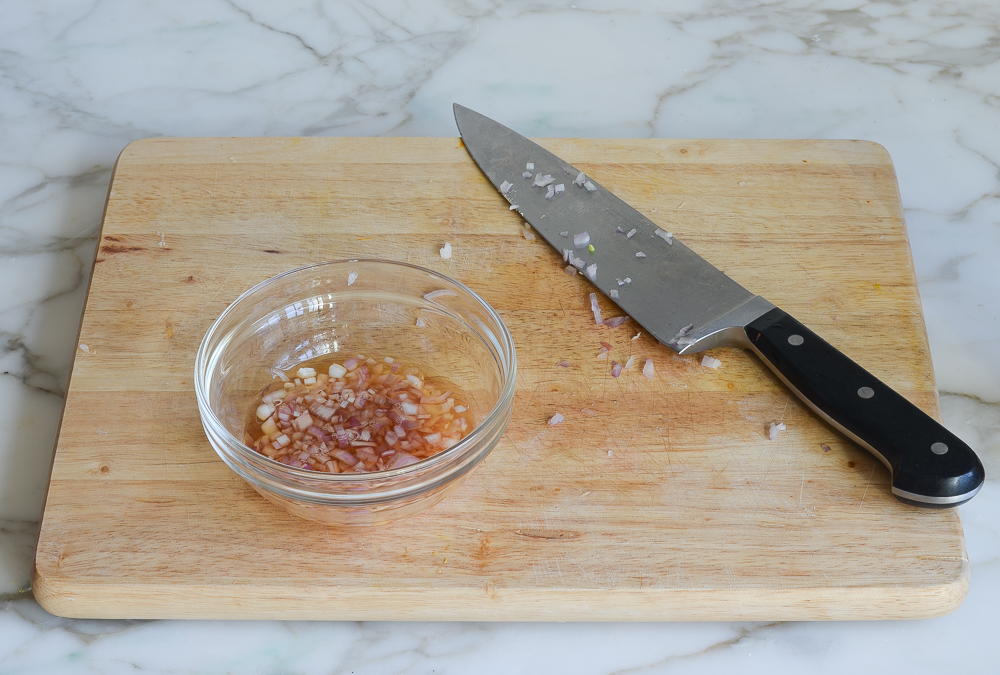
Step 4. Make the herb oil. In another bowl, mix the herbs, olive oil, salt, and black pepper.
Pro Tip: Chop the herbs as finely as possible so their essential oils release and flavor distributes evenly.
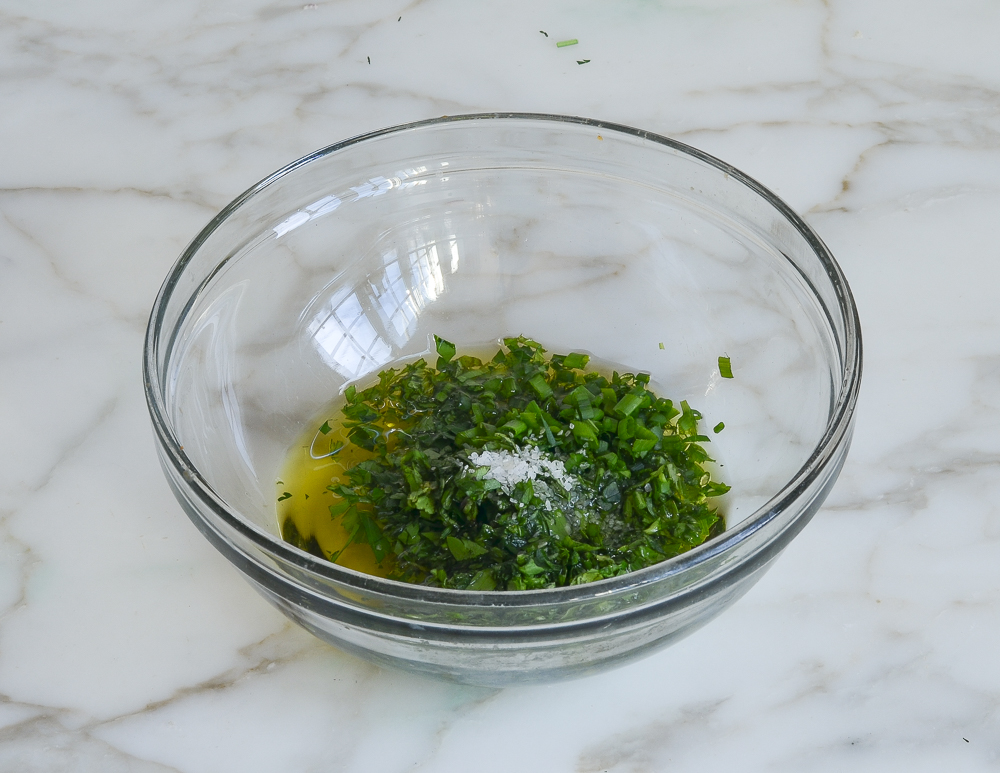
Step 5. Finish the salsa. Right before serving, use a slotted spoon to transfer the shallots (without the vinegar) into the herb oil. Stir, then taste and add 2 to 3 teaspoons of the vinegar, depending on how sharp the flavor is. Adjust salt if needed.
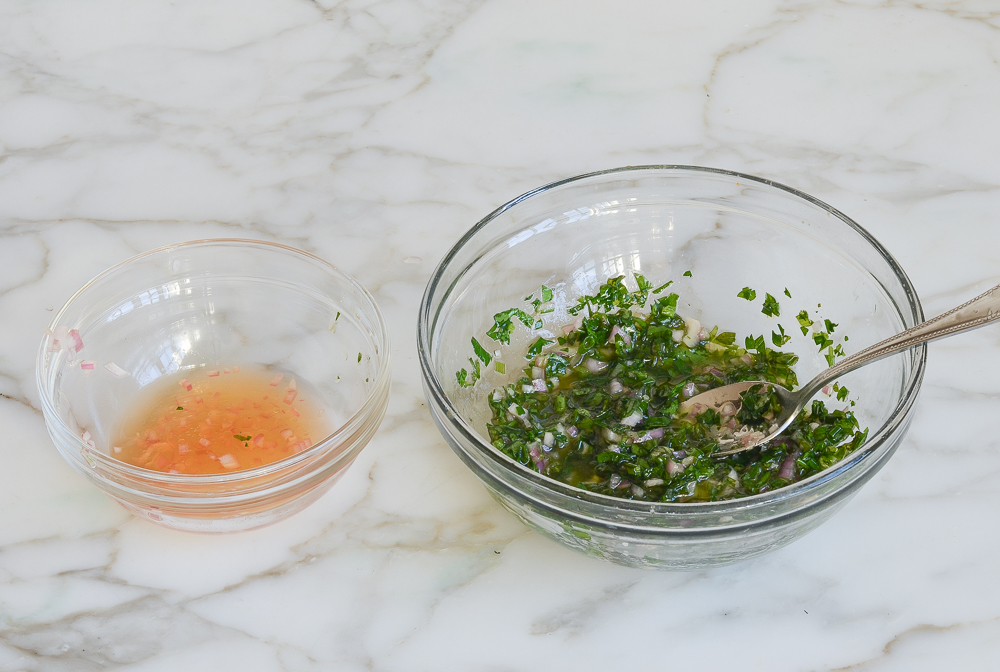
Step 6. Break and serve the salmon. Break the salmon into rustic pieces, spoon the herb salsa over the top, and serve.
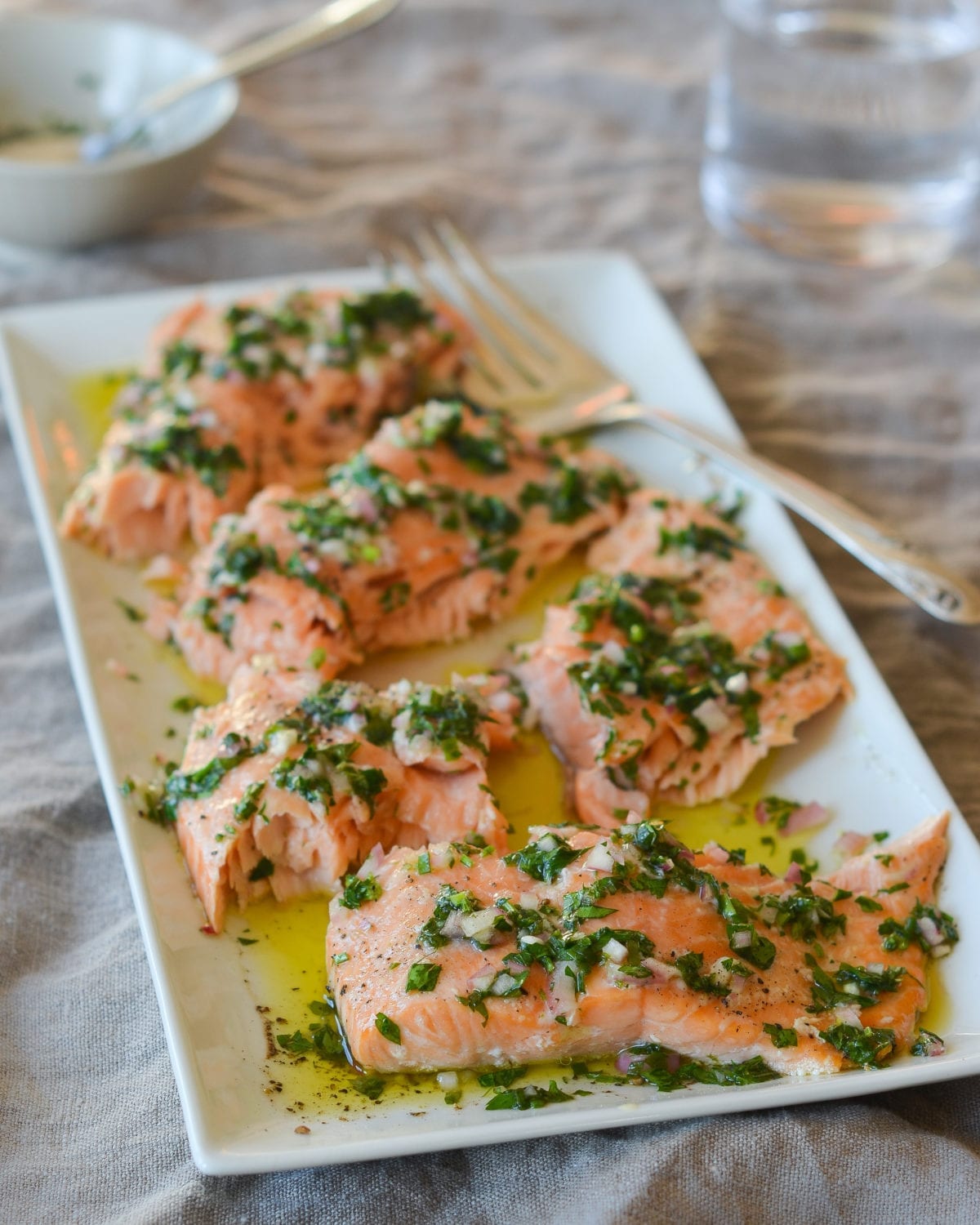
The salmon can be roasted a day ahead and refrigerated, and the salsa can be made up to two days in advance and chilled until ready to use.
More Salmon Recipes You may like
Slow-Roasted Salmon with French Herb Salsa
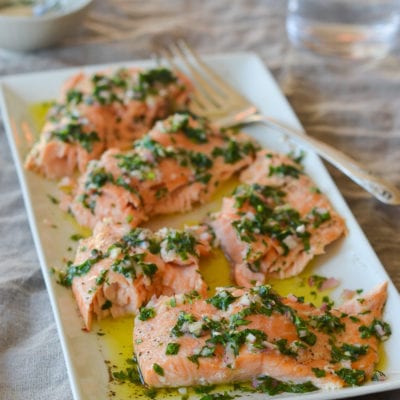
Ingredients
For the Salmon
- 1 (2-lb) salmon filet, pin bones and skin removed
- 1 tablespoon extra-virgin olive oil
- ¾ teaspoon kosher salt
For the French Herb Salsa
- 3 tablespoons finely diced shallot, from 1 medium shallot
- 3 tablespoons white wine vinegar
- 2 tablespoons very finely chopped fresh Italian parsley
- 1 tablespoon very finely chopped fresh chervil (okay to substitute more parsley if you can't find it)
- 1 tablespoon very finely chopped fresh chives
- 1 tablespoon very finely chopped fresh basil
- 1 teaspoon very finely chopped fresh tarragon
- 5 tablespoons extra-virgin olive oil
- ¼ teaspoon kosher salt
- Freshly ground black pepper
Instructions
For the Salmon
- Preheat the oven to 225°F (105°C) and set an oven rack in the middle position.
- Place the salmon on a baking sheet. Drizzle with the olive oil and sprinkle the salt evenly over top. Slide the pan into the oven and roast for 40 to 50 minutes, until the fish begins to flake in the thickest part of the filet when poked with a knife or your finger. (Because this method is so gentle on its proteins, the fish will appear translucent even when it's cooked.) Using a small spoon, scrape off any white coagulated proteins that may have formed on the salmon.
- Break the salmon into large, rustic pieces and spoon the French herb salsa (below) over top. This dish can be served hot, cold, or room temperature.
For the French Herb Salsa
- In a small bowl, combine the shallot and vinegar and let sit for 15 minutes to macerate.
- In a separate small bowl, combine the herbs, olive oil, salt, and a few grinds of black pepper.
- Just before serving, use a slotted spoon to add the shallot (but not the vinegar, yet) to the herb oil. Stir, taste, and add the vinegar as needed (I usually add 2 to 3 teaspoons). Taste and adjust salt, if necessary.
Notes
Nutrition Information
This website is written and produced for informational purposes only. I am not a certified nutritionist and the nutritional data on this site has not been evaluated or approved by a nutritionist or the Food and Drug Administration. Nutritional information is offered as a courtesy and should not be construed as a guarantee. The data is calculated through an online nutritional calculator, Edamam.com. Although I do my best to provide accurate nutritional information, these figures should be considered estimates only. Varying factors such as product types or brands purchased, natural fluctuations in fresh produce, and the way ingredients are processed change the effective nutritional information in any given recipe. Furthermore, different online calculators provide different results depending on their own nutrition fact sources and algorithms. To obtain the most accurate nutritional information in a given recipe, you should calculate the nutritional information with the actual ingredients used in your recipe, using your preferred nutrition calculator.
Gluten-Free Adaptable Note
To the best of my knowledge, all of the ingredients used in this recipe are gluten-free or widely available in gluten-free versions. There is hidden gluten in many foods; if you're following a gluten-free diet or cooking for someone with gluten allergies, always read the labels of your ingredients to verify that they are gluten-free.
Comments
Add a Comment Cancel reply
This site uses Akismet to reduce spam. Learn how your comment data is processed.
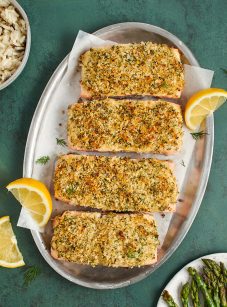
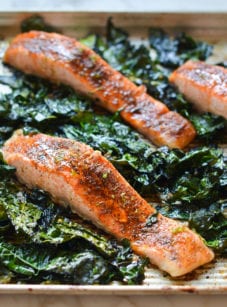
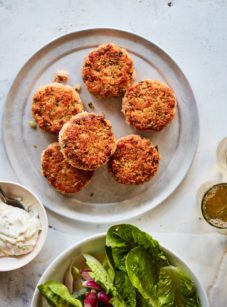
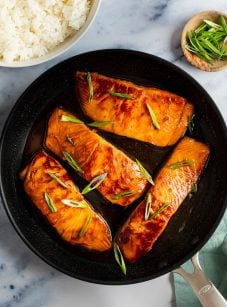
Another 5 star recipe from Jenn S.
Came out perfect ! Everyone loved this salmon . Nearly effortless !
I used to cook salmon at 400 for 15 min, this is sooooo much better.
Herb salsa was delish and I also made a lemon/dill mustard sauce on the side that everyone loved!
This recipe is amazing! I served this room temp as suggested, along with your roasted herb potatoes & a simple salad for a dinner party & received raves from around the table!! The salmon was delicately delicious and the salsa simply sang! Thank you for another wonderful meal! (As an aside, my husband questioned my cooking this for guests without trying it before. I told him not to worry- it’s Once Upon a Chef 😊).
I made this for a ladies’ luncheon but doubled the salsa recipe (it’s summer in AZ, so no fresh tarragon or chives. Used lots of parsley, green onion stems, added a smashed garlic clove, and more basil.) Since some people don’t like fish, I also sliced a whole rotisserie chicken breast into thick slices and both chicken and fish were dressed with the salsa. This recipe is a keeper! Don’t worry about skinning the raw filet. I rested the baked fish for a few minutes, flipped it over, and the skin peeled right off. I made it ahead and chilled it then removed from the fridge about 45 minutes in advance. It’s a very elegant and EASY make ahead dish and would be easy to multiply for a bigger crowd. I’ll be making this for other entertaining occasions. I have leftovers and will be making salmon cakes for tonight’s dinner!
If you make it ahead of time and serve at room temperature, when do you pour the salsa over it, right after cooking when it is hot or after it has been refrigerated and brought back to room temperature? Thank you in advance.
Hi Joy, wait until serving to pour the salsa over. 😊
Thank you for your lovely receipe. I have not cooked it yet. If I make it ahead how do I reheat it andat what temperature. Many thanks Lizzie.
Hi Lizzie, I really like this at room temperature, but if you’d prefer it warm, I’d reheat it in a 325-degree oven until it reaches your desired temperature. Hope you enjoy!
So easy! So delicious! We have this one on our regular rotation!
Hi Jenn,
Do you think I could cook this in a smoker? Any variation of time or temp?
Love your recipes.
Julia
Hi Julia, so glad you like the recipes. 😊
I do think it would work, but I don’t know about timing or temperature; I’d suggest looking for another recipe to get that guidance. I’d love to hear how it turns out if you try it!